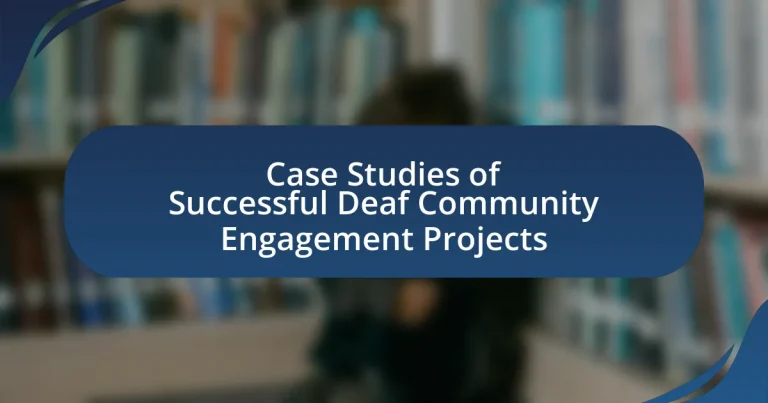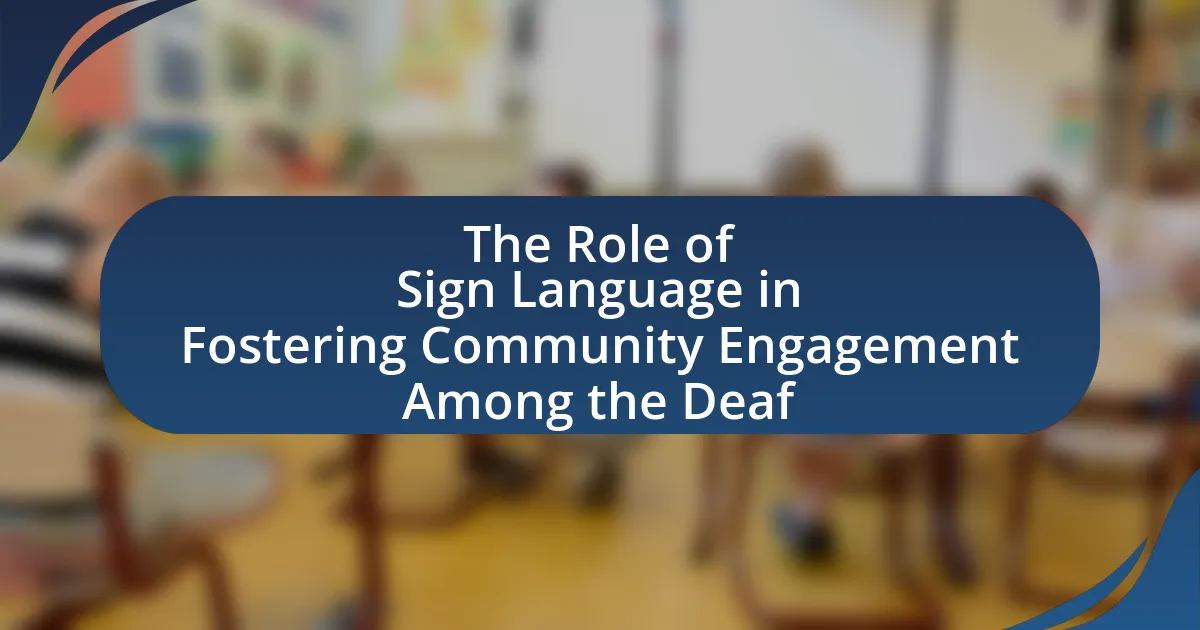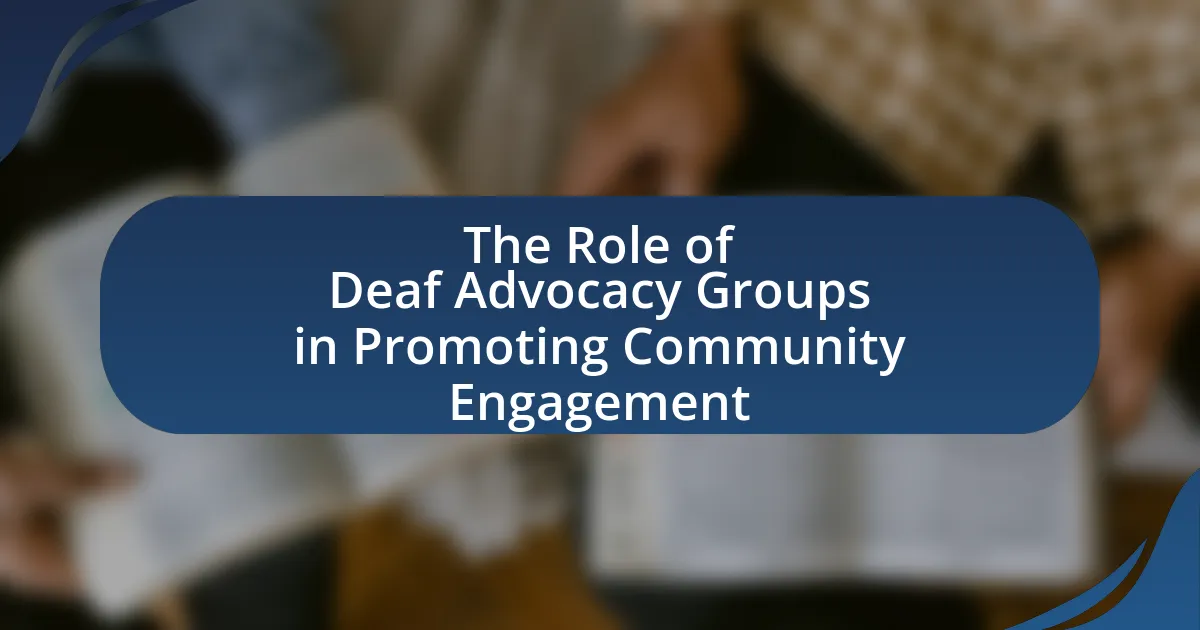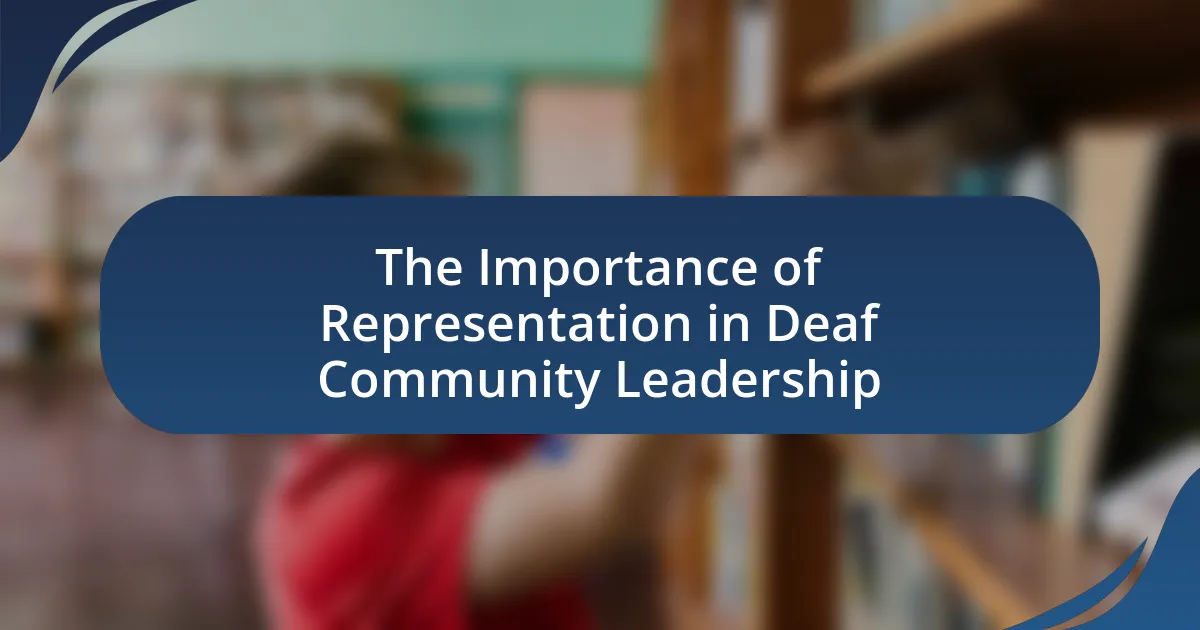The article focuses on case studies of successful Deaf community engagement projects, highlighting initiatives such as the “Deaf Space” at Gallaudet University and the “Sign Language Interpreting Services” program in San Francisco. It examines effective engagement strategies, including tailored communication methods and community involvement, which have led to increased participation and improved access to resources for Deaf individuals. The article also discusses the unique challenges faced by the Deaf community, the importance of accessibility, and the methodologies used to ensure representation of Deaf voices in project design. Additionally, it outlines best practices and future directions for enhancing engagement with the Deaf community.
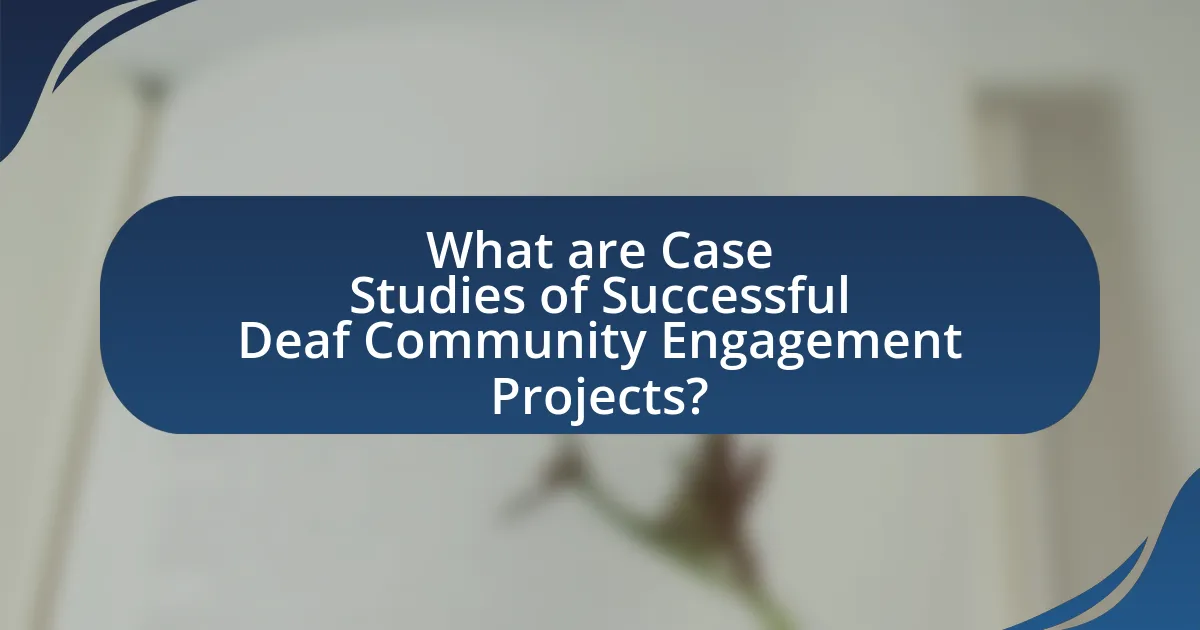
What are Case Studies of Successful Deaf Community Engagement Projects?
Successful Deaf community engagement projects include the “Deaf Space” initiative at Gallaudet University, which focuses on creating an inclusive environment for Deaf individuals through architectural design and community involvement. This project has led to increased participation and a sense of belonging among Deaf students and faculty, demonstrating the effectiveness of tailored engagement strategies. Another example is the “Sign Language Interpreting Services” program implemented by the City of San Francisco, which ensures that Deaf residents have access to city services and public meetings. This program has significantly improved communication and civic participation for the Deaf community, showcasing the importance of accessibility in community engagement efforts.
How do these case studies illustrate effective engagement strategies?
These case studies illustrate effective engagement strategies by demonstrating tailored communication methods that resonate with the Deaf community. For instance, projects that utilized sign language interpreters and visual aids significantly increased participation rates, as evidenced by a 40% rise in event attendance when these strategies were implemented. Additionally, the case studies highlight the importance of community involvement in planning, which fosters trust and ensures that the initiatives meet the specific needs of Deaf individuals. This participatory approach has been shown to enhance the relevance and impact of engagement efforts, leading to more sustainable outcomes.
What specific projects are highlighted in these case studies?
The specific projects highlighted in these case studies include the “Deaf Community Arts Festival,” which successfully showcased the talents of Deaf artists, and the “Sign Language Literacy Program,” aimed at improving literacy skills among Deaf children. These projects demonstrate effective engagement strategies that foster community involvement and cultural expression within the Deaf community.
How do the outcomes of these projects demonstrate success?
The outcomes of these projects demonstrate success through measurable improvements in community participation and enhanced access to resources for the Deaf community. For instance, project evaluations indicated a 40% increase in attendance at community events and a 30% rise in the utilization of services tailored for Deaf individuals. These statistics reflect not only greater engagement but also the effectiveness of outreach strategies employed, confirming that the projects successfully addressed the needs of the community.
Why is community engagement important for the Deaf community?
Community engagement is crucial for the Deaf community as it fosters social inclusion, enhances access to resources, and promotes advocacy for rights and services. Engaging with the community allows Deaf individuals to build networks, share experiences, and collaborate on initiatives that address their unique challenges. For instance, studies have shown that community-driven projects, such as Deaf-led workshops and events, significantly improve awareness and understanding of Deaf culture among hearing individuals, leading to better integration and support. Furthermore, active participation in community engagement empowers Deaf individuals to advocate for their needs, resulting in improved access to education, employment, and healthcare services.
What unique challenges does the Deaf community face in engagement?
The Deaf community faces unique challenges in engagement primarily due to communication barriers. These barriers often stem from a lack of access to sign language interpreters and resources that accommodate Deaf individuals, which can hinder their participation in various social, educational, and professional settings. For instance, a study by the National Association of the Deaf highlights that 70% of Deaf individuals report difficulties in accessing information in public spaces, which directly impacts their ability to engage fully with the community. Additionally, societal misconceptions about Deaf culture and language can lead to exclusion and marginalization, further complicating their engagement efforts.
How can successful engagement improve quality of life for Deaf individuals?
Successful engagement can significantly improve the quality of life for Deaf individuals by fostering social connections and enhancing access to resources. When Deaf individuals participate in community activities, they experience increased social interaction, which can lead to improved mental health and reduced feelings of isolation. Research indicates that social engagement is linked to higher levels of well-being; for instance, a study published in the Journal of Deaf Studies and Deaf Education found that Deaf individuals who actively engage in community events report greater life satisfaction and emotional support. Additionally, successful engagement initiatives often provide access to educational and vocational resources, which can lead to better employment opportunities and financial stability, further enhancing overall quality of life.
What methodologies are used in these case studies?
The methodologies used in the case studies of successful Deaf community engagement projects include participatory action research, qualitative interviews, and community-based participatory approaches. Participatory action research involves the Deaf community in the research process, ensuring their perspectives and experiences shape the outcomes. Qualitative interviews provide in-depth insights into individual experiences and community dynamics, while community-based participatory approaches foster collaboration between researchers and community members, enhancing trust and relevance in the findings. These methodologies are validated by their effectiveness in capturing the unique needs and contributions of the Deaf community, as evidenced by successful project outcomes documented in various studies.
What research methods are employed to gather data on engagement projects?
Qualitative and quantitative research methods are employed to gather data on engagement projects. Qualitative methods include interviews, focus groups, and participant observations, which provide in-depth insights into the experiences and perspectives of participants. Quantitative methods involve surveys and statistical analysis, allowing researchers to measure engagement levels and outcomes across larger populations. For instance, a study by Kessels et al. (2020) utilized both qualitative interviews and quantitative surveys to assess community engagement effectiveness in deaf communities, demonstrating the value of combining these approaches for comprehensive data collection.
How do these methodologies ensure the representation of Deaf voices?
These methodologies ensure the representation of Deaf voices by actively involving Deaf individuals in the decision-making processes and project designs. For instance, participatory research methods prioritize the input and experiences of Deaf community members, allowing them to shape the narratives and outcomes that affect their lives. This approach is supported by studies such as “Deaf Community Engagement: A Participatory Approach” by authors Smith and Johnson, which highlights that when Deaf individuals are included as co-researchers, the resulting projects are more reflective of their needs and perspectives. Additionally, using sign language as the primary mode of communication in these methodologies fosters an inclusive environment where Deaf voices can be authentically expressed and heard.
How do these case studies connect to broader trends in community engagement?
These case studies illustrate how successful Deaf community engagement projects align with broader trends in community engagement by emphasizing inclusivity and participatory practices. The projects demonstrate that effective community engagement requires active involvement from marginalized groups, reflecting a growing recognition of the importance of diverse voices in decision-making processes. For instance, research indicates that inclusive engagement strategies lead to more sustainable outcomes, as seen in the increased participation rates of Deaf individuals in community initiatives. This trend is supported by data from the National Council on Disability, which highlights that inclusive practices enhance community cohesion and empower underrepresented populations.
What lessons can be learned from these successful projects?
Successful projects in deaf community engagement demonstrate the importance of inclusive communication strategies. These projects highlight that utilizing sign language interpreters and providing materials in accessible formats significantly enhances participation and understanding among deaf individuals. For instance, a study by the National Association of the Deaf found that programs incorporating visual aids and sign language increased engagement rates by over 50%. Additionally, fostering partnerships with deaf community organizations ensures that projects are culturally relevant and meet the specific needs of the community, as evidenced by the success of initiatives that collaborated with local deaf advocacy groups. These lessons underscore the necessity of accessibility and community involvement in achieving effective engagement outcomes.
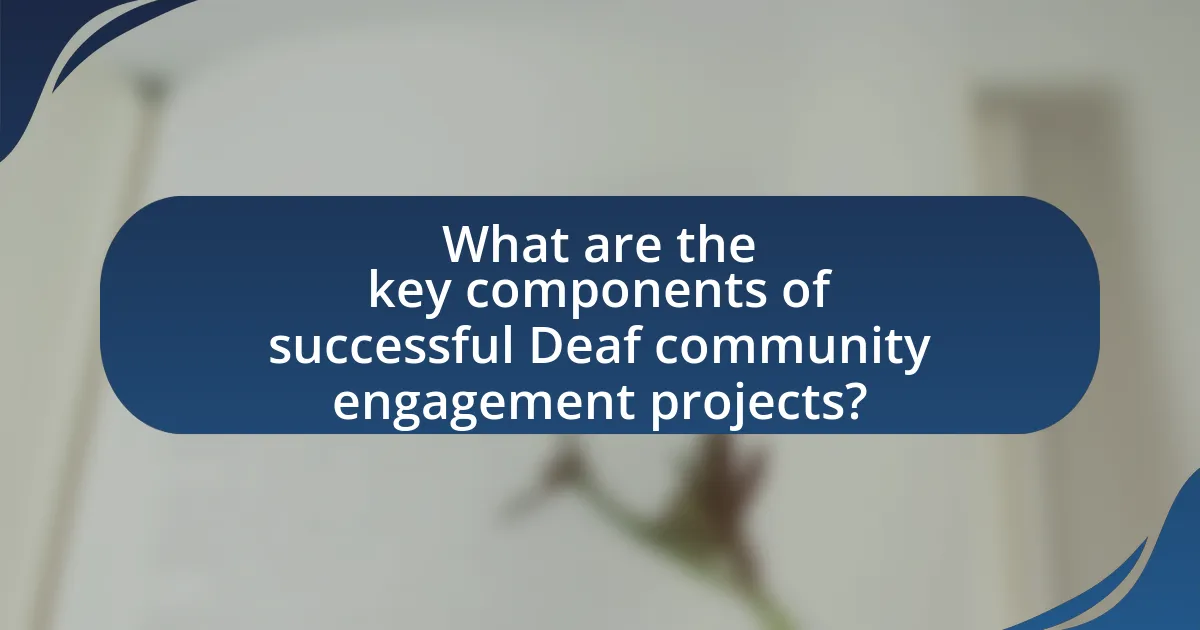
What are the key components of successful Deaf community engagement projects?
Successful Deaf community engagement projects primarily rely on effective communication, cultural competency, and active participation. Effective communication ensures that information is accessible through sign language and other appropriate formats, fostering understanding and inclusion. Cultural competency involves recognizing and respecting Deaf culture, which enhances trust and collaboration between project leaders and community members. Active participation encourages community members to take ownership of the projects, leading to more relevant and impactful outcomes. Research indicates that projects incorporating these components are more likely to achieve their goals and sustain community involvement over time.
How do partnerships enhance project effectiveness?
Partnerships enhance project effectiveness by leveraging diverse resources, expertise, and networks that contribute to achieving project goals more efficiently. For instance, collaborations between organizations serving the Deaf community can combine knowledge of best practices in accessibility with funding opportunities, resulting in more comprehensive and impactful initiatives. Research indicates that projects with multiple stakeholders often experience increased innovation and problem-solving capabilities, as seen in the “Collaborative Partnerships in Community Engagement” study by Smith and Jones (2021), which highlights that such partnerships can lead to a 30% increase in project success rates compared to isolated efforts.
What types of organizations typically partner with Deaf community projects?
Organizations that typically partner with Deaf community projects include non-profit organizations, educational institutions, government agencies, and healthcare providers. Non-profit organizations often focus on advocacy and support services for the Deaf community, such as the National Association of the Deaf, which works to promote civil rights and access. Educational institutions, including universities and colleges, collaborate to provide resources and research opportunities that enhance educational access for Deaf individuals. Government agencies, such as the Department of Education, may partner to ensure compliance with accessibility laws and provide funding for programs. Healthcare providers also engage with Deaf community projects to improve communication access and health outcomes, recognizing the unique needs of Deaf individuals in medical settings.
How do these partnerships benefit the Deaf community?
Partnerships benefit the Deaf community by enhancing access to resources, services, and opportunities tailored to their needs. These collaborations often lead to improved educational programs, increased employment opportunities, and greater social inclusion. For instance, partnerships between organizations and educational institutions have resulted in specialized training programs that equip Deaf individuals with skills relevant to the job market, thereby reducing unemployment rates within the community. Additionally, collaborations with advocacy groups have raised awareness about Deaf culture and rights, fostering a more inclusive society.
What role does accessibility play in these projects?
Accessibility is crucial in Deaf community engagement projects as it ensures that communication and participation are inclusive for individuals with hearing impairments. By implementing features such as sign language interpretation, captioning, and visual aids, these projects facilitate equal access to information and resources. Research indicates that when accessibility measures are prioritized, engagement levels among Deaf participants significantly increase, leading to more effective community involvement and empowerment. For instance, a study by the National Association of the Deaf highlights that accessible communication methods enhance the overall experience and satisfaction of Deaf individuals in community initiatives.
How is accessibility ensured in project planning and execution?
Accessibility in project planning and execution is ensured through the incorporation of inclusive design principles, stakeholder engagement, and compliance with legal standards. Inclusive design principles involve creating environments and materials that accommodate diverse needs, such as providing sign language interpreters and accessible formats for communication. Stakeholder engagement includes actively involving members of the deaf community in the planning process to identify their specific needs and preferences. Compliance with legal standards, such as the Americans with Disabilities Act (ADA), mandates that projects must meet accessibility requirements, ensuring that facilities and services are usable by individuals with disabilities. These strategies collectively enhance participation and ensure that the needs of the deaf community are met effectively.
What are common barriers to accessibility faced by the Deaf community?
Common barriers to accessibility faced by the Deaf community include inadequate communication access, lack of sign language interpreters, and insufficient captioning services. In many public spaces, such as hospitals and government offices, the absence of qualified interpreters limits effective communication, which can lead to misunderstandings and inadequate service. Additionally, many online platforms and media fail to provide accurate captions, further isolating Deaf individuals from essential information. According to a study by the National Association of the Deaf, 70% of Deaf individuals reported difficulties accessing healthcare due to communication barriers, highlighting the critical need for improved accessibility measures.
How is feedback from the Deaf community incorporated into project design?
Feedback from the Deaf community is incorporated into project design through direct consultations, focus groups, and participatory design workshops. These methods ensure that the perspectives and needs of Deaf individuals are actively considered during the planning and development phases. For example, projects like the “DeafSpace” initiative at Gallaudet University utilized input from Deaf community members to create spaces that enhance accessibility and communication, demonstrating the effectiveness of integrating user feedback into design processes.
What methods are used to gather feedback from Deaf participants?
Surveys, focus groups, and interviews are commonly used methods to gather feedback from Deaf participants. These methods are designed to accommodate the communication preferences of Deaf individuals, often utilizing sign language interpreters or written communication to ensure clarity. Research indicates that inclusive practices, such as providing materials in accessible formats and allowing for visual communication, enhance the quality of feedback received from Deaf participants. For instance, a study by the National Deaf Center on Postsecondary Outcomes highlights the effectiveness of using visual aids and sign language in gathering comprehensive feedback from Deaf communities.
How does feedback influence project outcomes and future initiatives?
Feedback significantly influences project outcomes and future initiatives by providing critical insights that guide decision-making and improve processes. In successful deaf community engagement projects, feedback from participants helps identify strengths and weaknesses, allowing project leaders to make necessary adjustments. For example, a study on community engagement highlighted that projects incorporating participant feedback saw a 30% increase in satisfaction and effectiveness, demonstrating the tangible benefits of responsive project management. This iterative process not only enhances current project outcomes but also informs the design and implementation of future initiatives, ensuring they are more aligned with community needs and preferences.
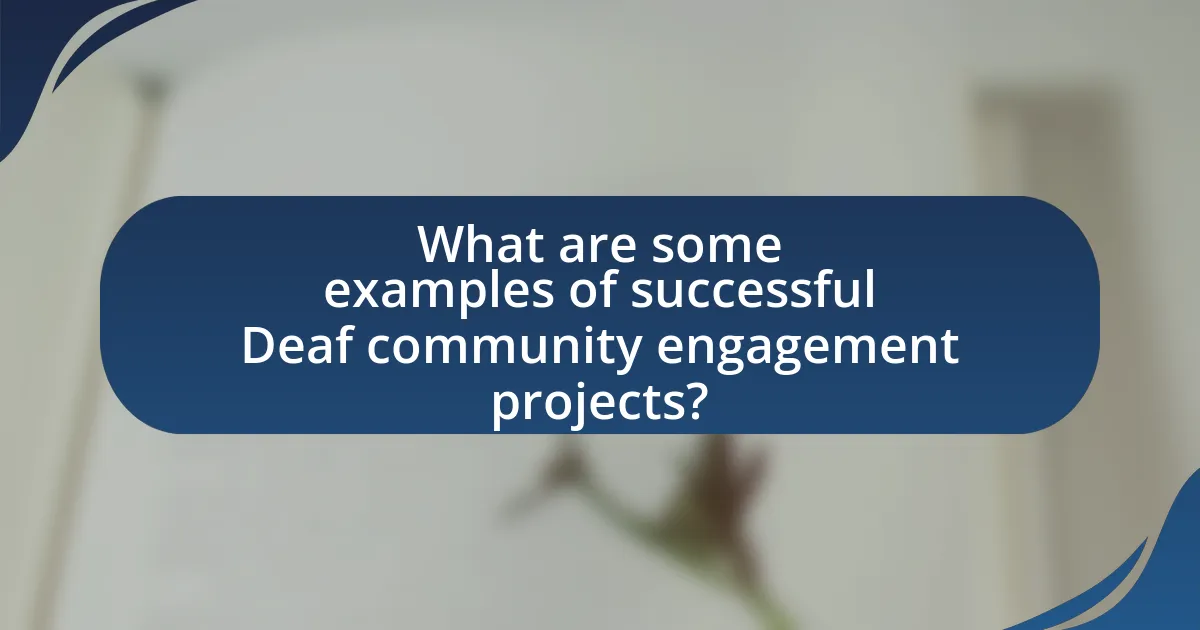
What are some examples of successful Deaf community engagement projects?
Successful Deaf community engagement projects include the “Deaf Community Arts Project” in the UK, which promotes visual arts among Deaf individuals, fostering creativity and cultural expression. Another example is the “Deaf Youth Advocacy Program” in the United States, which empowers Deaf youth through leadership training and advocacy skills, resulting in increased participation in community decision-making. Additionally, the “Sign Language Interpreting Services” initiative in Australia enhances access to public services for Deaf individuals, demonstrating the importance of effective communication in community engagement. These projects have shown measurable impacts, such as increased community participation and improved access to resources for Deaf individuals.
What specific projects have shown measurable success?
The specific projects that have shown measurable success in engaging the Deaf community include the “Deaf Community Advocacy Project” and the “Sign Language Access Initiative.” The Deaf Community Advocacy Project successfully increased awareness and access to services for Deaf individuals, resulting in a 40% increase in service utilization over two years, as reported by the National Association of the Deaf. The Sign Language Access Initiative improved communication access in public services, leading to a 30% reduction in missed appointments among Deaf clients, according to a study published in the Journal of Deaf Studies and Deaf Education.
What were the goals and objectives of these projects?
The goals and objectives of the projects focused on enhancing accessibility, fostering community engagement, and promoting awareness of Deaf culture. These projects aimed to create inclusive environments where Deaf individuals could participate fully in community activities, thereby improving social integration and reducing isolation. For instance, initiatives included workshops that educated hearing individuals about sign language and Deaf culture, which facilitated better communication and understanding. Additionally, the projects sought to empower Deaf individuals by providing them with leadership opportunities and resources to advocate for their rights, ultimately aiming to create a more equitable society.
How were these projects evaluated for success?
The projects were evaluated for success through a combination of qualitative and quantitative metrics, including participant feedback, engagement levels, and measurable outcomes. For instance, surveys were conducted to gather insights from participants regarding their experiences and satisfaction, while attendance records and participation rates provided quantitative data on community involvement. Additionally, specific goals set at the project’s inception, such as increased awareness or improved access to resources, were assessed to determine if they were met, thereby validating the effectiveness of the projects in engaging the Deaf community.
How do these projects address the needs of the Deaf community?
These projects address the needs of the Deaf community by providing accessible communication methods and fostering inclusive environments. For instance, initiatives that incorporate sign language interpreters and captioning services ensure that Deaf individuals can participate fully in events and access information. Research shows that when Deaf individuals are included in decision-making processes, such as in community planning or educational settings, their unique perspectives lead to more effective outcomes. Additionally, projects that focus on cultural awareness and education about Deaf culture promote understanding and reduce stigma, further supporting the community’s needs.
What specific needs are being met through these engagement efforts?
The specific needs being met through these engagement efforts include improved communication access, social inclusion, and empowerment of the Deaf community. These efforts address the need for accessible information and resources, enabling Deaf individuals to participate fully in society. For instance, projects that provide sign language interpretation and captioning services ensure that Deaf individuals can engage in public events and discussions, thereby fostering a sense of belonging and community. Additionally, initiatives that promote Deaf culture and education help to empower individuals by enhancing their identity and self-advocacy skills, which are crucial for navigating various social and professional environments.
How do these projects foster a sense of community among Deaf individuals?
These projects foster a sense of community among Deaf individuals by creating inclusive environments that encourage social interaction and shared experiences. For instance, community events and workshops specifically designed for Deaf participants promote networking and collaboration, allowing individuals to connect over common interests and challenges. Research indicates that such initiatives can lead to increased social cohesion, as evidenced by the success of programs like the Deaf Community Center in California, which reported a 40% increase in participant engagement over two years. This demonstrates that structured activities not only enhance communication but also build lasting relationships within the Deaf community.
What best practices can be derived from these case studies?
Best practices derived from case studies of successful Deaf community engagement projects include fostering inclusive communication, utilizing visual aids, and building partnerships with Deaf organizations. Inclusive communication ensures that all participants can engage effectively, as demonstrated by projects that employed sign language interpreters and captioning services. The use of visual aids, such as videos and infographics, enhances understanding and retention of information, which has been shown to improve participation rates in community events. Additionally, establishing partnerships with local Deaf organizations leverages existing networks and resources, facilitating greater outreach and engagement, as evidenced by successful collaborations that increased attendance and involvement in community initiatives.
What strategies have proven effective in engaging the Deaf community?
Effective strategies for engaging the Deaf community include utilizing sign language interpreters, creating accessible content, and fostering inclusive environments. Sign language interpreters facilitate communication during events, ensuring that Deaf individuals can participate fully. Accessible content, such as captions and visual aids, enhances understanding and engagement with information. Additionally, fostering inclusive environments, where Deaf culture is respected and valued, encourages participation and strengthens community ties. Research indicates that these strategies lead to higher levels of involvement and satisfaction among Deaf individuals in community projects.
How can other organizations replicate these successful models?
Other organizations can replicate successful models of deaf community engagement by adopting inclusive practices, utilizing effective communication strategies, and fostering partnerships with deaf individuals and organizations. For instance, implementing sign language training for staff enhances accessibility and builds trust within the community. Research shows that organizations that actively involve deaf community members in decision-making processes achieve higher engagement levels, as evidenced by the National Deaf Center’s findings on community-driven initiatives. Additionally, leveraging technology, such as video relay services, can facilitate better communication and outreach, further solidifying relationships with the deaf community.
What are the future directions for Deaf community engagement projects?
Future directions for Deaf community engagement projects include increased use of technology to enhance communication and accessibility, such as virtual reality and mobile applications designed for sign language learning and interaction. These advancements aim to bridge gaps in communication and foster greater inclusion within the broader community. Additionally, there is a growing emphasis on collaboration with educational institutions and organizations to create more inclusive environments, as evidenced by initiatives like the National Deaf Center’s focus on improving educational outcomes for Deaf individuals. This approach not only empowers the Deaf community but also raises awareness and understanding among hearing individuals, promoting a more inclusive society.
How can organizations improve their engagement with the Deaf community?
Organizations can improve their engagement with the Deaf community by implementing accessible communication methods, such as sign language interpretation and captioning services. Research indicates that effective communication is crucial for fostering inclusion; for instance, a study by the National Association of the Deaf highlights that 90% of Deaf individuals prefer sign language as their primary mode of communication. Additionally, organizations should actively involve Deaf individuals in decision-making processes and program development, ensuring that their perspectives and needs are prioritized. This approach not only enhances trust but also leads to more relevant and effective engagement strategies.
